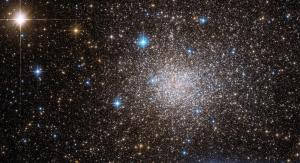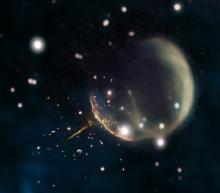Terzan 5, a globular cluster in the constellation Sagittarius, contains hundreds of pulsars, which are the rapidly spinning corpses of once mighty stars. It contains the highest concentration of pulsars in the galaxy. The cluster is also one of the heaviest in the galaxy, with a mass equal to about two million Suns but contained in a region only a few light-years across. Because it is so densely packed, collisions between stars may be fairly common. [ESA Hubble/NASA]
You are here
Terzan 5
At least 150 globular clusters inhabit the Milky Way Galaxy. They’re giant balls of stars, and most of them are at least 10 billion years old — the Milky Way’s oldest members. Yet no two are alike. There’s a wide range in size, mass, and how tightly their stars are packed together.
One cluster is about 10,000 times the mass of the Sun, and spans more than 150 light-years, so its stars are widely spaced. Another cluster is about two million times the Sun’s mass, but is only a few light-years across. That makes it one of the most tightly packed of all the globulars.
That cluster is known as Terzan 5. It’s 19,000 light-years away, on the outskirts of the Milky Way’s core.
One of its distinctions is that it contains many pulsars — the ultra-dense cores of once-mighty stars that exploded. A pulsar spins rapidly. One of those in the cluster, in fact, is the fastest in the galaxy — more than 700 revolutions per second.
The large number of pulsars may be a result of the cluster’s density. Because stars are so close together, collisions may be common. That causes more supernova explosions, which create pulsars — among the most interesting residents of this giant “city” of stars.
Terzan 5 is in Sagittarius. It climbs into good view, in the southeast, after midnight, and is low in the south-southwest at first light. Its stars form the outline of a teapot. Terzan 5 is above the spout — in the “steam” of the Milky Way.
Script by Damond Benningfield
Get Premium Audio
Listen to today's episode of StarDate on the web the same day it airs in high-quality streaming audio without any extra ads or announcements. Choose a $8 one-month pass, or listen every day for a year for just $30.






